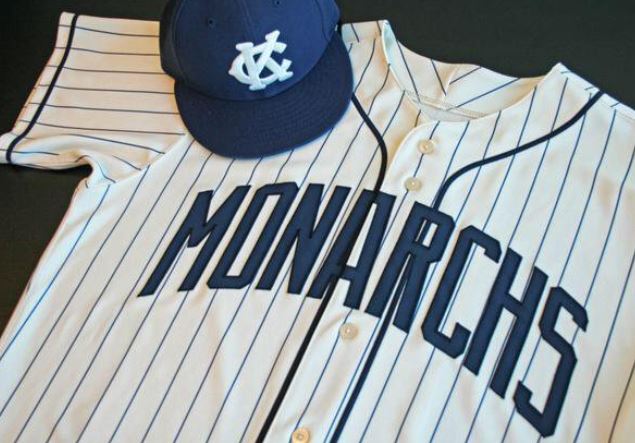The following article appeared in the Topeka Capital-Journal on June 22 – you can read it by clicking here.
Perhaps no city in the United States is more closely connected to Negro League baseball than Kansas City. Fittingly, the Kansas City Royals dedicate one game each season to celebrate the legacy of baseball played by non-white players prior to integration in 1947.
When the Royals host Minnesota on Sunday, they will do so in Kansas City Monarchs uniforms, pitted against the St. Paul Gophers in the annual Salute to the Negro Leagues.
New to the Royals this season, outfielder Billy Hamilton recognizes the importance of Negro League baseball to Kansas City, and is happy for the chance to celebrate it.
“The Negro League celebration is just special to the African American guys who are playing baseball today, to show that we’re still supporting (its memory),” Hamilton said. “What they did to give us the chance to play the game of baseball is a beautiful thing.
“It’s awesome to put on the type of uniform they used to wear, to see what the game looked like back in the day,” the centerfielder said. “I’m so glad that baseball is doing that for a lot more teams. It seemed like for a while it was just a couple of teams doing it. But now it seems like more teams around the league are getting into it.”
From the 1880s until 1947, segregation restricted the major leagues solely to light-skinned players. Due to the color barrier, Negro League teams provided an alternative for non-whites.
The Kansas City and Topeka areas were a hotbed for baseball amongst the African-American community for more than half a century. In fact, the Topeka Giants were celebrated as the “Black Champions of the West” in 1906, and the Kansas City Giants were named the “Colored Champions of 1909.”
Arguably the most important singular event in segregated baseball occurred at the Paseo YMCA in 1920, when eight owners gathered to form the Negro National League, which included the Kansas City Monarchs. The formation of a league brought new legitimacy to the brand of baseball played by non-whites.
From 1920 to 1965, the Monarchs were the most consistently competitive, profitable and well-known of the Negro League franchises. They crisscrossed the nation with players like Satchel Paige and Buck O’Neill, and were the team that launched Jackie Robinson, who broke the color barrier shortly after World War II.
Similar to African-Americans, dark-skinned Hispanic players were barred from the major leagues prior to 1947, a fact not lost on Puerto Rican native Jorge Lopez. It is estimated that up to 20 percent of Negro League players were from outside the U.S.
“It’s an honor to remember those Negro Leaguers and what they did for us,” the 26-year-old pitcher said. “We have a lot of respect for them and what they went through. I know the hard time they (endured) to play the game.”
The major leagues gradually accepted more and more non-whites, and today the game is brimming with players from Latin America. 2017 saw the highest percentage of non-white players in major league history at 42.5 percent. Of that number, 31.9 percent were categorized as Latin American.
Lopez said he can’t imagine growing up prior to integration and being told that he could not play in the major leagues. But he guessed that Latin Americans at that time were probably appreciative of the opportunity the Negro Leagues presented.
“It had to be weird to be told that,” Lopez said. “I couldn’t tell (how I would feel about it) because I didn’t grow up with that. It had to be so tough. Maybe Latin Americans saw it in a positive way, to have the chance to come to the United States and play, and make the most of it.
“But I’m so thankful that things seem to be getting better with every generation. When you hear about what that was like, it just makes you thankful things are so much better. And so you just appreciate what they did. So it’s an honor to play now and to show our appreciation.”
Fans are encouraged to suit up too. Sunday games were the biggest and best attended of the week for Negro League clubs, and fans often came straight from church, dressed in their Sunday best. Kauffman Stadium will host some nattily dressed guests again this year, as “Dressed to the Nines” has officially become a part of the annual celebration.
The short, baggy pants and the billowy jerseys with the Monarchs’ iconic KC logo on the chest will be auctioned to raise money for Kansas City’s Negro Leagues Baseball Museum. The first 10,000 fans will receive a Kansas City Monarchs Short Bill Cap.
The Royals/Monarchs’ opponent this Sunday, the St. Paul Gophers, was an all-black barnstorming unit from 1907 to 1916. For some of the period, they went by the name St. Paul Colored Gophers, Twin City Gophers, and Minneapolis Gophers.
The 2019 season has been a forgettable one in Kansas City. The game with Minnesota on Sunday, however, provides a reminder of an even more important struggle than that on the field. For one day, the Royals become the Monarchs, and win or lose, they play for something truly historic.
